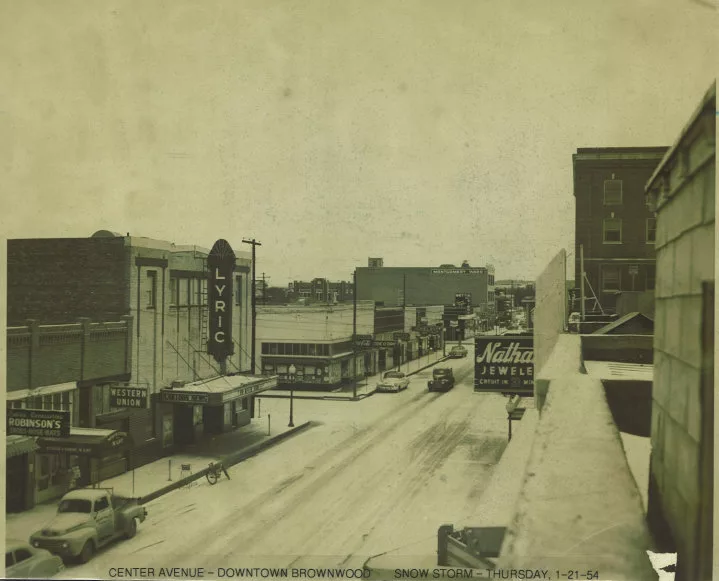
I want to talk about what theaters were like pre-talkies, during the silent film era when theaters did not have expensive and bulky sound equipment, but to do that I need to lay the groundwork to show what Brownwood was like (theater-wise) back in the day.
In the 1930s in Brownwood, there were three theaters operating downtown. They were the Lyric, the Gem, and the Queen theaters. All three theaters shared a very tight geography. The Lyric on the 300 block of Center Ave is, of course, still with us. It was built around 1917 or 1918. The Queen is still with us too, but it is now the wonderful Intermission Bookshop in the 200 Block of Center, right across from Coursey Park. The Gem was directly across the street from the Lyric.
By 1942-43, due to the flood of soldiers in the area because of the war and the building of Camp Bowie, there would be eight theaters downtown. Seven of the downtown theaters were on Center Avenue. Six of the theaters were on the same side of Center (our own little Broadway!) while the Lyric sat alone on the east side of Center. Only the Granada Theater (on the site that is now Citizens National Bank on Lee Street) was not on Center Ave. According to an old newspaper article, the Granada and possibly the Plaza (later called the Palace) were owned by the father of Oscar-winning actress Jennifer Jones. I could be wrong about this, so correct me if I’m wrong, but I suspect the Plaza (Palace) was located at 301 N. Center right across from the Brownwood Manor. I suspect the Texas Theater was either where the City Hall is now located in the 100 block of Center, or in what is now the parking lot adjacent to it. The Bowie Theater building still stands, it is on the 400 block of Center and it is currently occupied by Solaris Hospice.
But forget all that. Don’t forget it, but that was all just information you might want to know. Brownwood was a happening place in the 1940s! But before that, in the 1930s, there were three theaters operating downtown… the Lyric, the Gem, and the Queen. Before the advent of talkies, which didn’t really become a “thing” until around 1929 in the big cities, the world of theater was a LOT different.
Because the Lyric is still with us and operating as a theater, and because it had been in operation since before the end of the First World War, we’ll kind of focus our imagination on that theater. You can go there soon and watch a play (Agatha Christie’s The Mousetrap is playing in February!) and use your imagination to see what theaters were like after the Great War and up until all the new theaters opened when a hundred thousand soldiers descended on Brownwood.
JAZZ
Jazz was the distinctive sound and feel of the 1920s when the Lyric was a young theater. “Movies” (moving pictures) were quite a new entertainment phenomenon. The earliest films were just silent moving pictures of trains steaming down tracks or horses running. Still, there was always jazz. A local orchestra would be in the “orchestra pit” and play during the moving pictures. Sheet music was sent with the films, and the orchestras had to be good at sight-reading. At about the time The Lyric opened, movies with storylines and plots were still quite new and would have been rare in this area of Texas. And frankly, the theaters were a lot more than “movies.” In the 1920s, there were two kinds of theater… “Legitimate” theater, usually consisted of whole plays, dramas, opera, or proper orchestral performances. “Vaudeville” was considered illegitimate theater, but it was the most popular by far. Legitimate theater was dying, and Vaudeville was booming. With three theaters downtown before the building of Camp Bowie, rest assured that most of the entertainment offerings would have been of the illegitimate kind. Don’t think this means it was banned or frowned on – it was by some people – it is just a classification of how entertainment people considered the offerings.
The 1920s was about Jazz and Vaudeville. Vaudeville was a loose confederation of theater houses, promoters, managers, and entertainers who traveled from place to place to perform what amounted to happy variety shows. In one evening’s show, you might see an opening hot jazz performance, then maybe a few actors doing scenes from Shakespeare, followed by a trained parrot act, followed by a duo of comedians, followed by another jazz performance, or maybe a magician. Comedians were very popular, and the comedy was usually of the physical kind. This would have been the bulk of the offerings available in the early 1920s. Every theater employed dozens and dozens of people, from ticket sales agents, hawkers who would hand out flyers to people walking downtown (remember, there were a lot of theaters for a small downtown area, and they competed,) refreshment workers, uniformed ushers who would escort patrons to their seats, and, of course, an orchestra. Nearly every form of entertainment at the time required an orchestra. Every part, every formal ball, graduation, retirement party, required musicians. Musicians were needed everywhere, which is why public schools began having music training and bands. Between the buildup to WWI and through the mid-1930s and the Great Depression, especially in the boom-boom 1920s, the demand for musicians was so high that recruiters, theater owners, band leaders, and promoters competed to hire musicians. A town the size of Brownwood would have had hundreds of musicians, the demand increasing every year until the Depression hit, the talkies took over, and the new theaters, outfitted with high-end sound equipment, could replace the need for musicians. During the 1920s, a theater the size of the Lyric would have likely had between 40 and 50 employees, including a house orchestra. The musicians could augment their income by performing at parties and weddings when they weren’t working at the theater.
The best of the musicians from the big cities and small towns all over the country migrated to places like Chicago, New York City, Los Angeles, and New Orleans – which explains the high quality of the musicians recording during the Jazz Age.
Go to the Lyric soon. Take in a show, and for a moment let your imagination drift. If you’re quiet enough you can hear the trumpets, clarinets, and trombones still echoing in the place.

***
Michael Bunker is a local columnist for BrownwoodNews.com whose columns appear on Wednesdays and Sundays on the website.